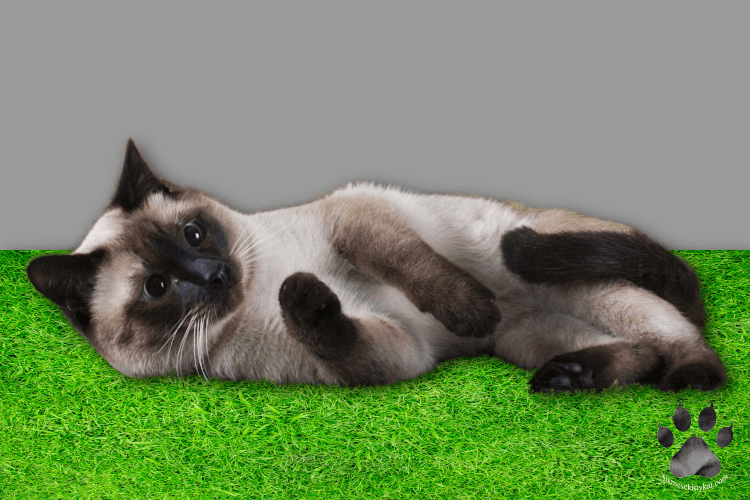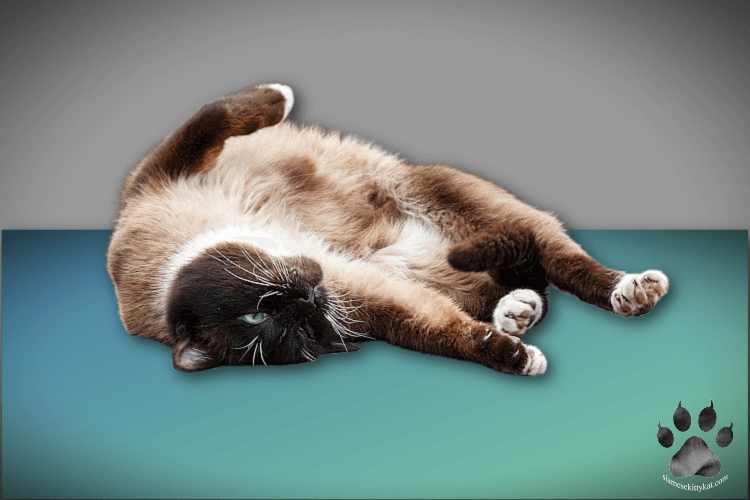Most Siamese cats love to chase their tails. But why do they do it? Some people say that they do it because they’re bored. Others believe that it’s a way to get exercise.
Batman, my Siamese cat, is the biggest tail chaser I have ever seen. He will stalk his tail until he gets excited and starts spinning around in circles. It is hilarious to watch him go crazy over his own tail. He will keep chasing it until he gets tired or until I distract him with a toy or some food.
Let’s take a closer look at why Siamese cats chase their tails and how you can deal with this behavior.
What Does it Mean if a Cat Chases its Tail?
All cat lovers have seen their feline friend chasing its tail at some point. Either your cat will chase it for a few seconds and then give up, or it will be a long-running battle.
It may seem like a playful game to us, but this behavior has a deeper meaning.
1. Kittens often chase their tails to practice their hunting skills. This is a natural behavior that helps them to become better hunters as they grow up.
Kittens are curious creatures. Anything that moves is sure to capture their attention. Tails, in particular, resemble snakes, making them perfect pouncing targets for young kittens.
With their sharp claws and quick reflexes, kittens can have a lot of fun chasing tails. They will leap and pounce at them as if they were prey. This behavior is instinctive and helps them to hone their hunting skills.
2. For cats, chasing their tails is a way of releasing built-up energy and frustration. It also provides them with a sense of satisfaction when they catch their tails.
3. Some cats may chase their tails if they have fleas or other parasites. The parasites may make the tail itch, and the cat tries to scratch it by chasing it.
You can try using a flea comb to remove the fleas and their eggs from the fur. Be careful not to hurt your cat while combing his coat.
You can also use flea shampoo or spray to kill the fleas. Be sure to follow the directions on the package. Consider consulting your veterinarian on how to best treat your cat.
4. It could be that your cat is reacting to pain, itchiness from an infection, or skin allergies. Take him to the vet for a check-up if he displays other signs of discomfort. These include excessive grooming, bald spots, or redness of the skin.
5. Tail chasing can also be a sign of neurological problems or feline anxiety. It’s best to have your cat evaluated by a professional to rule out any serious health concerns.
6. Feline hyperesthesia syndrome is a condition causing cats to chase their tails. It is a heightened sense of touch and sensitivity to stimuli, which can lead to various symptoms. These include twitching of the skin, tail chasing, and aggression.
FHS is thought to be hereditary, and affected cats may show signs of the condition from a young age.
When To Be Concerned About a Cat Chasing Their Own Tail

Adult cats may chase their tail for entertainment, like they did when they were kittens. However, sometimes there may be more to it than that.
Keep an eye on your cat’s behavior.
Your kitty may be feeling a little bit stressed and is looking for a way to release some of that built-up energy. Try to identify any changes in his environment that may be causing the stress. This could be due to a new pet in the home, or even something as simple as a loud noise outside.
Try to make some changes once you’ve identified the source to help reduce your cat’s anxiety. Provide more hiding spots, increase playtime, or use calming pheromone products.
Add some new toys or scratching posts, or spend more time petting and playing with him.
Of course, it’s always possible that your cat is only chasing its tail for fun. However, keep an eye out for other signs of distress if your cat is fixated on its tail. Give your vet a call if you’re worried.
What if My Siamese Cat is Chasing Another Cat’s Tail?
There are a few reasons your cat may be chasing another cat’s tail.
1. Cats will often chase each other’s tails as a way of playing or communicating. They often take turns chasing each other’s tails when they play together. This is a way for them to release their energy and have fun together. It also helps them to bond and build trust with each other.
2. Sometimes, this behavior can also be a way of showing dominance over another cat.
It’s best to consult a vet if your cat is chasing another cat’s tail aggressively or violently. This will help you understand your cat’s motivations and how to best address the issue.
There’s no need to worry if your cat is only playing and not being aggressive. Ensure that both cats enjoy the game and that there’s no risk of injury.
There are a few things to keep in mind if your cat is chasing another cat’s tail:
It may be best to keep them separated if the tail-chasing cat seems aggressive. Chasing could become a real fight if they’re not used to each other or if one feels territorial.
How Can I Get My Cat to Stop Chasing His Tail?

You can provide your cat with some alternatives to chase, so it won’t chase its tail.
- Buy a small toy your cat can chase, such as a ping pong ball.
- Encourage your cat to chase other objects, such as a piece of string or a feather on a stick.
- Provide your cat with a scratching post or cat tree to scratch and claw. This will help divert its attention from its tail and meet its natural hunting instincts.
- Try playing with your cat using a wand toy or laser pointer. This provides him with mental and physical stimulation.
- Ensure your cat has food, water, and a clean litter box to avoid potential behavioral problems.
Siamese cats have a fascination with their tails. This behavior is another sign of a Siamese cat’s silly personality. However, there can be a few different reasons why Siamese cats chase their tails.
Kittens are often curious and exploratory. Chasing their tails is a way for them to learn about their bodies and their surroundings. Adult Siamese cats may chase their tails for fun or as a way to relieve boredom.
It may be a sign that something is wrong if the behavior is new for the cat. It’s best to take your cat to the vet for a check-up in this case.
Want to immerse yourself more in the captivating world of Siamese cats? I’ve got all the information you need from their distinct color points to their fun personalities: Siamese Cats: Unique Features and Personality
